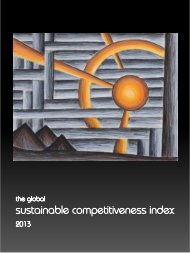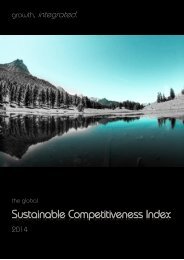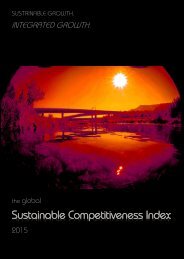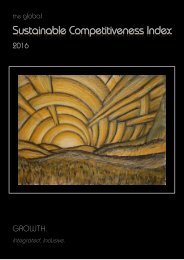Global Competetiveness Report
Create successful ePaper yourself
Turn your PDF publications into a flip-book with our unique Google optimized e-Paper software.
Sustainability Indicators<br />
Methodology<br />
Natural Capital<br />
The natural capital of a nation or country<br />
consists of the natural environment, which is<br />
defined by a mixture of size, population,<br />
geography, climate, biodiversity and natural<br />
resources (renewable and non-renewable<br />
resources), as well as the depletion of those<br />
resources. The combination of these factors<br />
and the level of depletion of the natural<br />
resources due to human activity and climate<br />
change represents the future potential of<br />
sustaining a prosperous livelihood for the<br />
population and the economy of a nation.<br />
Indicators used encompass forests and<br />
biodiversity indicator, agricultural indicators,<br />
land degradation and desertification, water<br />
resources, minerals and energy resources,<br />
pollution indicators and depletion indicators.<br />
Resource Intensity<br />
The more efficient a nation is using resources,<br />
the smaller the negative impacts of a<br />
potential supply scarcity of resources (energy,<br />
water, and minerals). Higher efficiency is also<br />
equal to lower cost per production unit in<br />
agriculture, industrial production, and to a<br />
lesser extend also in the service sector.<br />
Efficient use of resources and energy is an<br />
indicator for a nation’s ability to maintain or<br />
improve living standard levels both under a<br />
business-as-usual scenario of the future and<br />
under changing external economic or geopolitical<br />
circumstances and influences.<br />
Indicators used cover water usage and<br />
depletion, energy usage, energy intensity<br />
and energy sources, climate change<br />
emissions and intensity as well as certain raw<br />
material usage. However, data availability for<br />
raw materials consumption other than steel is<br />
limited and therefore could not be included.<br />
Natural<br />
Capital<br />
&<br />
Natural<br />
Capital<br />
Depletion<br />
18 data<br />
points<br />
Resource<br />
Intensity<br />
14 data<br />
points<br />
Arable land per capita<br />
Potentially arable land<br />
Cereal yield<br />
Land degradation<br />
Desertification risk<br />
Forest area & forest loss<br />
Extreme weather events<br />
Renewable freshwater<br />
Inland water<br />
Biodiversity potential<br />
Endangered species<br />
Resource depletion<br />
Ecological footprint<br />
Population density<br />
Energy self-sufficiency<br />
Air pollution<br />
SO2 emissions<br />
Hazardous waste<br />
Energy per capita<br />
Energy per GDP<br />
GHG per capita<br />
GHG per GDP<br />
Water per capita<br />
Water per GDP<br />
Steel per capita<br />
Steel per GDP<br />
Electricity per capita<br />
Electricity per GDP<br />
Renewable electricity<br />
Coal electricity<br />
Hydropower electricity<br />
Transmission losses<br />
The <strong>Global</strong> Sustainable Competitiveness Index<br />
19








